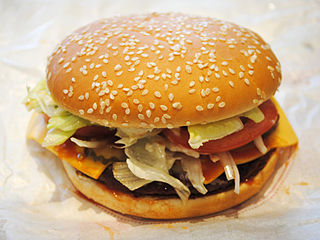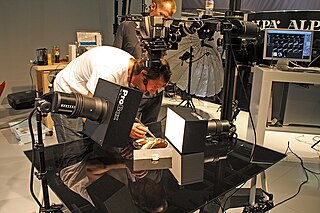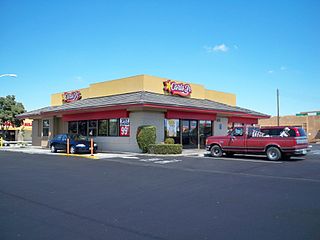
A fast-food restaurant, also known as a quick-service restaurant (QSR) within the industry, is a specific type of restaurant that serves fast-food cuisine and has minimal table service. The food served in fast-food restaurants is typically part of a "meat-sweet diet", offered from a limited menu, cooked in bulk in advance and kept hot, finished and packaged to order, and usually available for take away, though seating may be provided. Fast-food restaurants are typically part of a restaurant chain or franchise operation that provides standardized ingredients and/or partially prepared foods and supplies to each restaurant through controlled supply channels. The term "fast food" was recognized in a dictionary by Merriam–Webster in 1951.

Burger King Corporation is an American multinational chain of hamburger fast food restaurants. Headquartered in Miami-Dade County, Florida, the company was founded in 1953 as Insta-Burger King, a Jacksonville, Florida–based restaurant chain. After Insta-Burger King ran into financial difficulties, its two Miami-based franchisees David Edgerton (1927–2018) and James McLamore (1926–1996) purchased the company in 1959 and renamed it "Burger King". Over the next half-century, the company changed hands four times and its third set of owners, a partnership of TPG Capital, Bain Capital, and Goldman Sachs Capital Partners, took it public in 2002. In late 2010, 3G Capital of Brazil acquired a majority stake in the company, in a deal valued at US$3.26 billion. The new owners promptly initiated a restructuring of the company to reverse its fortunes. 3G, along with partner Berkshire Hathaway, eventually merged the company with the Canadian-based doughnut chain Tim Hortons, under the auspices of a new Canadian-based parent company named Restaurant Brands International.

The Whopper is the signature hamburger and an associated product line sold by the international fast food restaurant chain Burger King and its Australian franchise Hungry Jack's. Introduced in 1957, the hamburger has undergone several reformulations, including changes to portion size and bread used. The hamburger is well known in the fast food industry, with Burger King advertising itself as "the Home of the Whopper" and naming its kiosk stores the BK Whopper Bar. In response to the Whopper, Burger King's competitors have developed similar products designed to compete against it.

The Burger King is a king character used as the primary mascot for the fast-food restaurant chain of the same name. The first iteration of the Burger King was part of a sign at the first Burger King restaurant in Miami, Florida, in 1955. Later signs showed the King sitting on a "burger throne" as well as atop the BK sign while holding a beverage. In the early 1970s, Burger King started using a small and animated version of the King in its children's advertising, voiced by Allen Swift. In 1976, the original animated King was replaced by the "Marvelous Magical Burger King" which was a red-bearded and Tudor-era king who ruled the Burger King Kingdom and performed magic tricks that were mostly sleight-of-hand but sometimes relied on camera tricks or involved his "Magic Ring" which could summon copious amounts of food. The Burger King Kingdom advertisements were discontinued in the late 1980s in favor of the BK Kids Club Gang and other advertising programs.

A value menu is a group of menu items at a fast food restaurant that are designed to be the least expensive items available. In the US, the items are usually priced between $0.99 and $2.99. The portion size, and number of items included with the food, are typically related to the price.

The Big King sandwich is one of the major hamburger products sold by the international fast-food restaurant chain Burger King, and was part of its menu for more than twenty years. As of March 2019, it is sold in the United States under its 1997 Big King XL formulation. During its testing phase in 1996–1997, it was originally called the Double Supreme and was configured similarly to the McDonald's Big Mac—including a three-piece roll. It was later reformulated as a more standard double burger during the latter part of product testing in 1997. It was given its current name when the product was formally introduced in September 1997, but maintained the more conventional double cheeseburger format.

Food photography is a still life photography genre used to create attractive still life photographs of food. As a specialization of commercial photography, its output is used in advertisements, magazines, packaging, menus or cookbooks. Professional food photography is a collaborative effort, usually involving an art director, a photographer, a food stylist, a prop stylist and their assistants. With the advent of social media, amateur food photography has gained popularity among restaurant diners.

Fast food advertising promotes fast food products and utilizes numerous aspects to reach out to the public.

The BK Stacker sandwiches are a family of cheeseburgers sold by the international fast-food restaurant chain Burger King.

The Burger King Specialty Sandwiches are a line of sandwiches developed by the international fast-food restaurant chain Burger King in 1978 and introduced in 1979 as part of a new product line designed to expand Burger King's menu with more sophisticated, adult oriented fare beyond hamburgers. Additionally, the new line was intended to differentiate the company from other fast food hamburger restaurants at the time. Since the line's introduction, the other sandwiches have been discontinued, leaving the chicken offering, the Original Chicken Sandwich, as the primary product left. Additionally, other sandwiches that utilize the same roll as the chicken sandwich have been introduced to the company's menu both domestically and internationally since the original product line was introduced.
Since it was founded in 1954, international fast food chain Burger King has employed many advertising programs. During the 1970s, its advertisements included a memorable jingle, the inspiration for its current mascot the Burger King and several well-known and parodied slogans, such as Have it your way and It takes two hands to handle a Whopper. From the early 1980s until approximately 2002, Burger King engaged a series of advertising agencies that produced many unsuccessful slogans and programs, including its least successful campaign, Where's Herb?.
As far back as the 1970s, international fast food restaurant chain Burger King has attempted to introduce a premium line of burgers. These sandwiches are part of a system which eventually became known as the barbell strategy; a plan designed to expand Burger King's menu with both more sophisticated, adult-oriented fare along with products that are more value-oriented. This program is intended to bring in a larger, more affluent adult audience who will be willing to spend more on the better quality products on one side while maintaining a lower cost value menu dedicated to a more cost-conscious audience on the other. The hope is that the customers would be drawn in initially for the lower prices of the value-menu and upgrade to the more expensive products, upping overall sales.
The predecessor to what is now the international fast food restaurant chain Burger King was founded on July 23, 1953, in Jacksonville, Florida, as Instant Burger King. Inspired by the McDonald brothers' original store location in San Bernardino, California, the founders and owners, Keith J. Cramer and his stepfather Matthew Burns, began searching for a concept. After purchasing the rights to two pieces of equipment called "Insta" machines, the two opened their first stores around a cooking device known as the Insta-Broiler. The Insta-Broiler oven proved so successful at cooking burgers, they required all of their franchises to carry the device. After the original company began to falter in 1959, it was purchased by its Miami, Florida, franchisees James McLamore and David R. Edgerton. The two initiated a corporate restructuring of the chain; the first step being to rename the company, Burger King. The duo ran the company as an independent entity for eight years, eventually expanding to over 250 locations in the United States, when they sold it to the Pillsbury Company in 1967.
When the predecessor of international fast food restaurant chain Burger King (BK) first opened in 1953, its menu predominantly consisted of hamburgers, French fries, soft drinks, milkshakes, and desserts. After being acquired by its Miami, Florida franchisees and renamed in 1954, BK began expanding its menu by adding the Whopper sandwich in 1957, and has since added non-beef items such as chicken, fish, and vegetarian offerings, including salads and meatless sandwiches. Other additions include a breakfast menu and beverages such as Icees, juices, and bottled waters. As the company expanded both inside and outside the United States, it introduced localized versions of its products that conform to regional tastes and cultural or religious beliefs. To generate additional sales, BK occasionally introduces limited-time offers of special versions of its products, or brings out completely new products intended for either long- or short-term sales. Not all of these products and services have been successful; in 1992, Burger King introduced limited table service featuring special dinner platters, but this concept failed to generate interest and was discontinued.
Burger King Dinner Baskets were a series of products introduced in 1993 by the international fast-food restaurant chain Burger King. The products were designed to add appeal to families and customers looking for a "higher class" meal found in family style restaurants.

Carl's Jr. Restaurants LLC is an American fast food restaurant chain operated by CKE Restaurant Holdings, Inc., with franchisees in North & South America, Asia, Oceania, Europe and Africa.

The fast-food restaurant chain Burger King was the first major fast food chain to introduce a grilled chicken sandwich to the marketplace, in 1990, six months before Wendy's and four years before McDonald's. Since then, Burger King, and its Australian franchise Hungry Jack's have offered a variety of grilled chicken sandwiches, as have Wendy's and McDonald's.

Dollar Cravings is the value menu of American fast-food restaurant Taco Bell. Dollar Cravings was launched August 18, 2014 in reaction to the new McDonald's and Wendy's value/dollar menus. The current menu contains 13 food items. Dollar Cravings replaced Taco Bell's previous value menu Why Pay More. A Taco Bell spokesperson said few of the food items from the Why Pay More menu will remain in Dollar Cravings.













